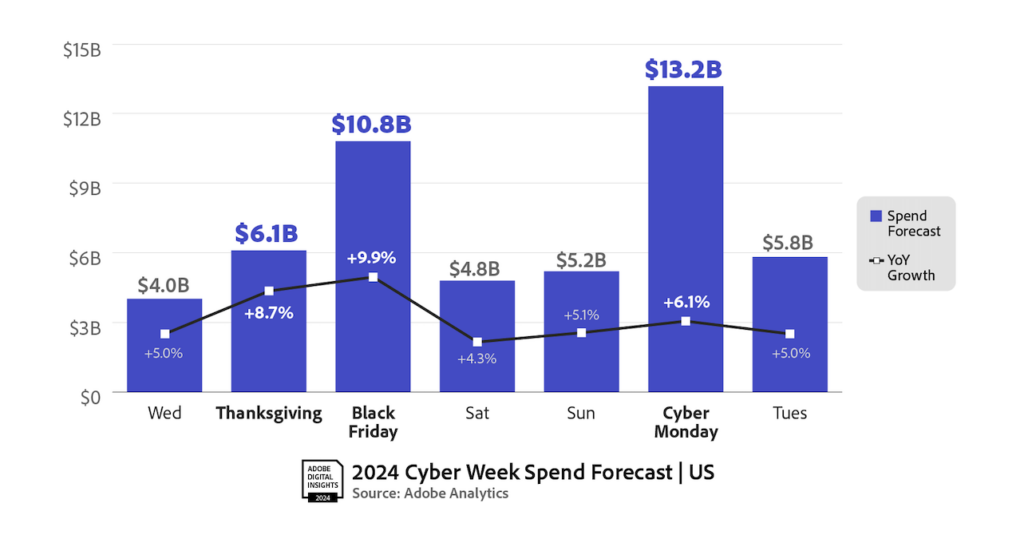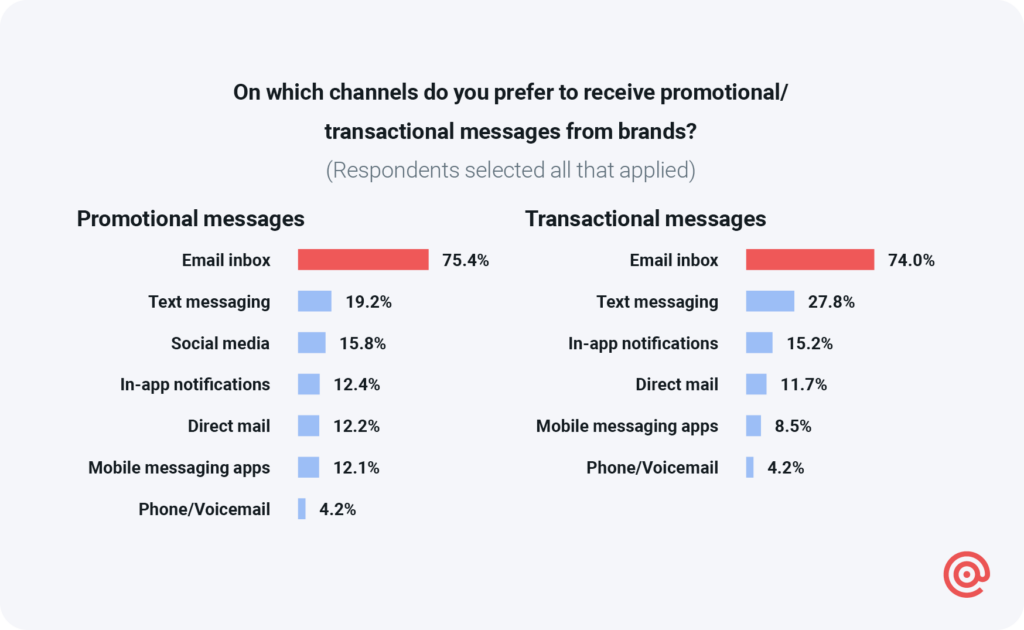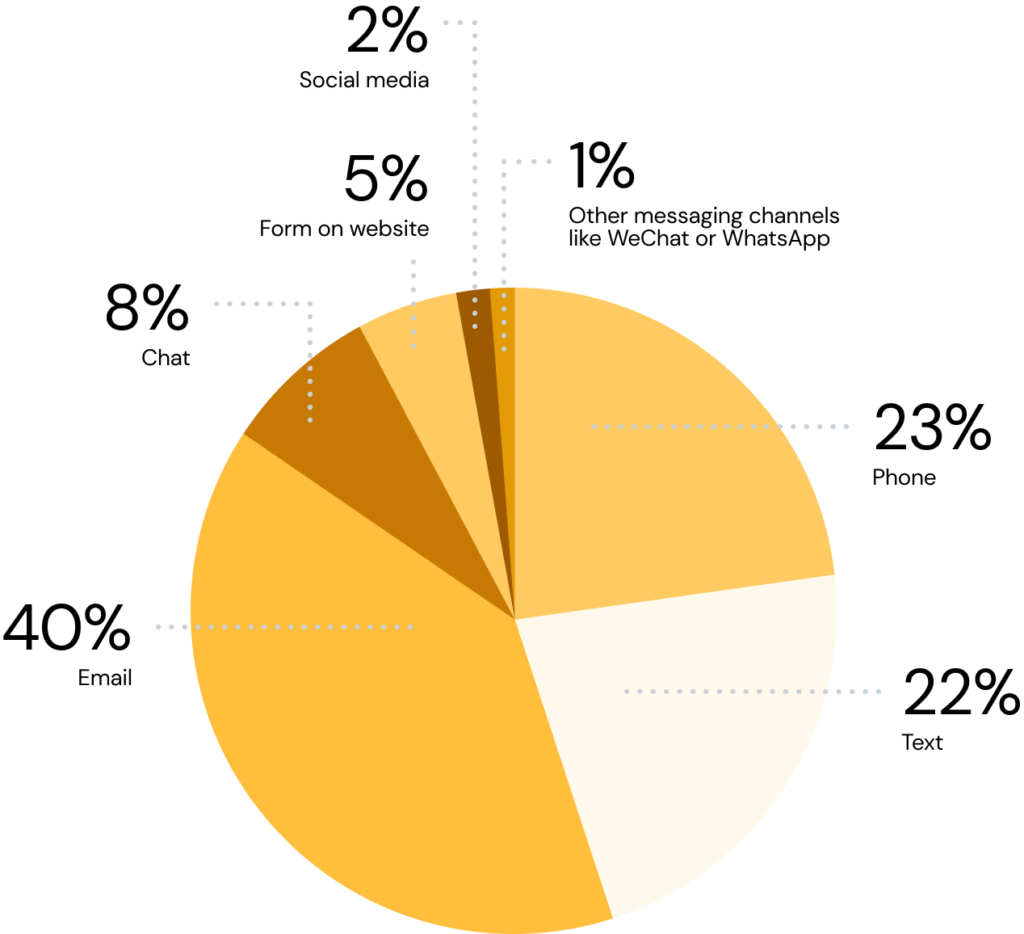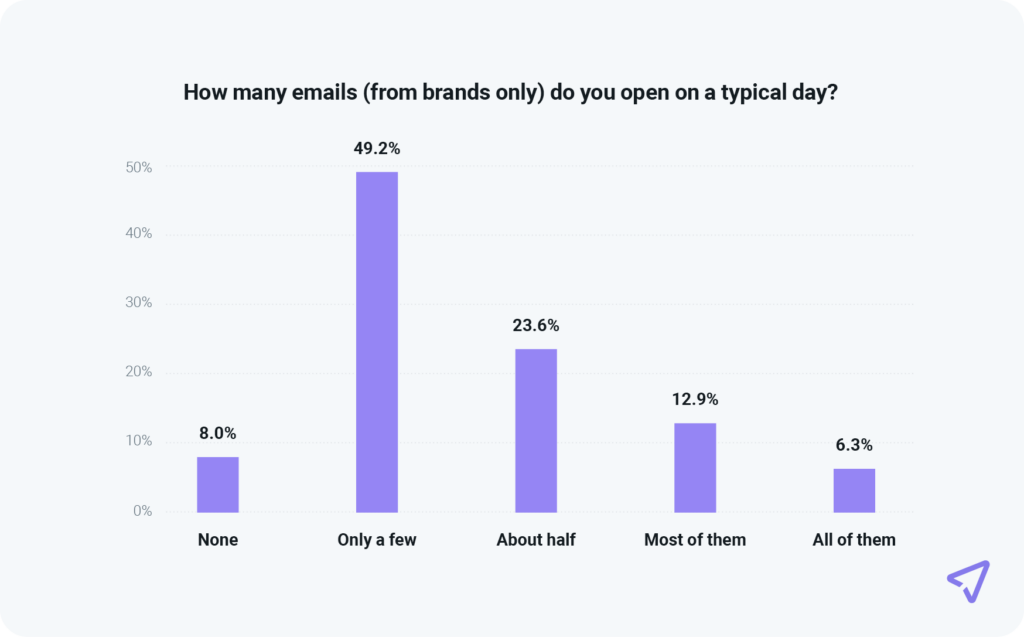Email Marketing
Black Friday Email Marketing 2024: Avoid These 12 Disastrous Mistakes

Email Marketing

It’s that time of year again. Black Friday, Cyber Monday, Cyber Week and the entire holiday shopping season are back. By now, your Black Friday email campaigns are probably planned and ready to launch.
Of course, it never hurts to double-check your Black Friday email marketing strategy. If you believe in Murphy’s Law, you know that anything that can go wrong, certainly could go wrong (and probably will).
If you’re “the worrying kind” of email marketer, we’ve got a few potential problems you may not have on your list yet. And if you’ve got more of a “let the chips fall where they may” kind of an attitude, here’s why you should be more concerned with your Black Friday email performance.
We probably shouldn’t have to tell you why Black Friday and Cyber Week are such a big deal. (Oh! See what we did there?) But these astronomical numbers are kind of a tradition. And after all, the holidays are all about traditions. So, here goes…
The biggest reason why Black Friday emails matter is because there is a lot of money on the table in terms of consumer spending. According to Adobe Analytics, U.S. shoppers are expected to drop $240.8 billion during the 2024 holiday shopping season. That’s an 8.4% year-over-year increase from 2023.
A sizable chunk of that holiday consumer spending happens during Cyber Week with noticeable spikes on Black Friday and Cyber Monday. Interestingly, Cyber Monday typically outpaces Black Friday, but the day after Thanksgiving is when things really start cooking.

The reason Black Friday email marketing matters so much in all of this is because email is the most preferred channel for receiving promotional communications from brands.
We’ve got plenty of original research to back this up. Let’s take a look at what the surveys say…
According to Sinch Mailgun’s report, Email and the customer experience, 75% of consumers in the U.S. UK, France, Germany, and Spain chose email as a preferred channel for promotional messages.
Almost as many of those survey respondents (74%) chose email as a preferred channel for transactional messages. And transactional emails are unsung heroes of Cyber Week. They keep your customers informed about their purchases and shipments during the hectic holiday season.

You may notice that text messaging was the second most popular option among these consumers. A new study from Sinch, The art and heart of meaningful customer connections, found different yet somewhat similar results.
Rather than selecting all channels they preferred, Sinch’s survey asked U.S. consumers to pick just one preferred channel for brand communications. In this case, 40% of people picked email while text messages came in second at around 22%.

So as an email marketer, this should be reassuring. Your holiday email campaigns are going to drive tons of BFCM results and revenue. When the company breaks things down after everyone gets back from break, you’ll be the hailed as a hero, right?
But wait… it’s not that easy compadres… and you know it. The challenge email marketers face is getting good engagement in those increasingly crowded inboxes.
Sinch Mailjet’s report, The path to email engagement 2024, found that 49% of consumers only open a few emails from brands on a typical day and 8% don’t open any at all.

Let’s be honest, Black Friday and Cyber Monday aren’t exactly “typical days.” Consumers may be more likely to engage with promotional emails on these days. However, it’s also true that there will be more emails in their inboxes during Cyber Week and beyond.
To get the most out of your Black Friday and Cyber Monday email campaigns, you need to be on top of your game. You don’t want silly mistakes tripping you up.

While there are plenty of ways to make Black Friday mistakes with email marketing, we’re going to focus on a dozen different issues that could be disastrous. Before you hit send on your Black Friday campaigns, make sure you’ve addressed these possible problems.
Once upon a time, there was a difference between Black Friday and Cyber Monday. On the Friday after Thanksgiving, people poured into shopping malls and big box stores, trampling each other for deals. On Monday, people slacked off at work while taking advantage of online promotions. Now, we’ve mixed it all together into an entire week of consumerism.
Today, not only does even more shopping happen online, it happens on mobile phones. More than half of online holiday spending is attributed to mobile. Adobe Analytics forecasts $128.1 billion of that $240.8 billion will be mobile spend.
You know where this is going. If you expect good Black Friday email performance, those campaigns better be responsive and mobile-friendly. Sinch Mailjet’s email engagement report found more than 70% of consumers primarily use a mobile device to check email.
Unfortunately, coding responsive emails is still a top challenge for many email teams. In fact, Sinch Mailjet’s Inbox Insights report found it is the top design and development challenge.
A smart move is to take a mobile-first approach to email design and development. That means thinking about how your campaigns look and function on smartphones and then adjusting those layouts for desktop. The best way to do this with email code is to use min-width media queries to adjust for screen size rather than max-width (IYKYK).
Everyone is going to write Black Friday email subject lines with urgency. And they’ll all be talking about sales, discounts, BOGO offers, and limited supplies. If your Black Friday email subject lines sound the same as every other special offer out there, your campaigns will be easily ignored.
So, you’ve got to get creative. Maybe that means personalizing subject lines, using emojis, or taking advantage of preheader text. But “Our Black Friday Sale Starts Now” may not do the trick.
According to Sinch Mailjet’s consumer research, people say the brand or sender name is the most important factor when deciding whether to open an email. However, nearly 80% of those surveyed also indicated the promise of a discount in the subject line was at least somewhat important.
If you can work details of your Black Friday and Cyber Monday offer into a concise, clear, and compelling subject line, that might be the best way to cut through the noise.
Need some ideas? Here are several Black Friday email subject lines we like:
While you’re working on those creative Black Friday email subject lines, don’t forget about writing creative calls-to-action (CTAs) too. The design and copy of those CTA buttons needs to encourage your customers to click and tap their way to your website for some shopping.
A lot of Black Friday email templates contain… well, the color black. A little on the nose, sure. But according to color psychology, black is also a good way to convey luxury and exclusivity.
If you’re familiar with dark mode email development challenges, you already know that some email clients will automatically invert the colors you’re using in your HTML email background. That means it is possible that a dark background could be inverted into a light background when a recipient has dark mode turned on.
That’s not the effect you wanted, and it’s not what subscribers using dark mode want to receive either.
Now, most email clients will recognize that you’re already using a dark theme. However, Outlook 365 may not, and Gmail may mess with some of your colors too.
One way to handle this problem is to make use of the media query prefers-color-scheme: dark. This detects if the email recipient has dark mode turned on, and lets you tailor your CSS styles for dark mode.
However, be aware that Gmail does not support prefers-color-scheme. For some expert advice on how to handle dark mode and Gmail, check out these tips from Rémi Parmentier.
We are big proponents of email accessibility around here. People with disabilities may be even more likely to do their holiday shopping online. So, it’s the responsibility of email marketers to ensure that the inbox experience is inclusive to all.
That includes coding accessible emails for those using screen readers. But another important consideration is color blindness.
Red-green color blindness is the most common. It impacts 1 in 12 men and 1 in 200 women. And what are two of the most popular colors to use during the holidays? Yep – red and green.
Black Friday email campaigns don’t have to be holiday-themed, but many are. While you don’t need to eliminate red and green in your email designs, try to avoid using those colors to convey meaning or in a way where important information gets lost. Get more tips on designing accessible holiday emails for people with color blindness.

Another accessibility issue with Black Friday marketing campaigns is an abundance of image-only emails. It’s a bit shocking to see how many big brands are sending promotional emails that are one giant graphic with no live text.
Screen readers can interpret the alt text of an image. But it’s highly unlikely you’ll be communicating an entire email campaign in image alt text (not to mention it’s a bad idea).
According to acccesiBe, more than 7 million Americans use screen readers. That’s around 2% of the population, which may not sound like a lot, but it could represent a sizable chunk of your list that can’t engage with image-only emails.
Besides accessibility, some subscribers may have image downloading turned off. That happens by default in Outlook inboxes. If your entire message is in the image, campaign performance could be disastrously disappointing.
A Black Friday email blast to every subscriber on your list might make sense in some situations. However, in most cases, you’ll be able to deliver more relevant holiday shopping promotions with segmentation.
Take advantage of the zero- and first-party data you’ve collected through your website and online forms to understand what kinds of Black Friday email promotions and products different segments will find engaging. Don’t forget that lots of people are shopping for others rather than themselves.
Can you segment for parents and grandparents buying gifts for kids? How about spouses trying to find the perfect presents for their significant other? Past purchase behaviors can also inform what subscribers are interested in buying this time of year.
Even geographic locations can help you decide what to promote in Black Friday emails. For example, subscribers in Florida and Arizona may not be as interested in warm and cozy winter sweaters compared to the Minnesotans on your list.
What happens after online shoppers click on a Black Friday email CTA? Sure, you did your job as an email marketer. But if the website experience doesn’t jive with the email campaign, your results in terms of online sales may suffer.
Emails and landing pages need to work together to effectively earn conversions. Now’s the time to make sure the assets you’re using in Black Friday emails match what subscribers see when they land on your ecommerce site to shop. Here are a few quick tips:
If your email and web teams work separately, this is a good time to break down those silos and start collaborating on Black Friday digital marketing strategy together.
Most importantly, make sure your emails do not send subscribers to the wrong landing page – or worse yet – a 404 page.
When the insanity of Black Friday subsides, the next item on the agenda will be evaluating how your campaigns performed. You’ll want to attribute as much as you can to the email channel. But marketing metrics can get messy if you’re unprepared.
One important way to track email marketing performance is with UTM parameters on links in your campaigns. Make sure you’re on the same page with the web or data team about what those parameters should be, including how UTMs are formatted.
Beyond tracking the email channel, what else do you want to know? If you’re sending multiple campaigns, use parameters that help you identify the success of one email from another. You could even track whether subscribers are clicking on specific elements like buttons, text links, or product images.
Another challenge with tracking Black Friday email performance relates to increased privacy measures from mailbox providers. Yes, we’re still talking about Apple’s Mail Privacy Protection (MPP). These features can inflate open rates, making it unclear how well your subject line really worked. However, you may be able to use email analytics to see which subscribers are using MPP.
Discover how Sinch Email on Acid can help you find out which of your subscribers are using Apple’s MPP. Once you know, you can segment those contacts so you can review their metrics separately, giving you a clearer picture of open rates.
The holidays are hectic, and everything goes into full gear right after Thanksgiving. Black Friday shoppers are getting tons of emails, visiting loads of websites, and inevitably… some items will get left in their online shopping carts.
If you aren’t already using abandoned cart emails, now is a good time to start. And if you do send these reminder emails, you may want to adjust your strategy for Black Friday. That could mean different messaging that adds urgency to bring people back before a promotion ends. Or it could mean adjusting the timing of these automated messages. Maybe your abandoned cart emails need to be sent sooner – before the shopper makes a purchase somewhere else.
According to TechReport, the global cart abandonment rate (CAR) is over 75%, and it’s at its highest during holiday shopping. Abandoned cart emails can help with that.
According to statistics from the ecommerce personalization platform, Bariliance, abandoned cart emails see open rates as high as 49%. So, nearly half of those messages get opened. The average click rate is close to 9% and the typical conversion rate (meaning a recovered transaction) is around 8%.
When your brand does earn those Black Friday sales, email comes into play once again. Transactional emails keep your customers informed with order confirmations, shipping updates, and more.
These messages can be extremely important during the holidays when getting a package on time matters more than ever. But what happens when transactional emails land in spam or get blocked from delivery? That’s a huge Black Friday mistake.
One way to prevent transactional messages landing in spam is to separate transactional mail streams from promotional emails using separate subdomains. For more on this approach,
A sudden spike in email volume and sending frequency during Black Friday may also prompt mailbox providers to filter your messages into spam, especially if you’re using a new IP or domain. So, an IP warmup may be necessary first.
Get more Black Friday email deliverability advice in a free, on-demand webinar from Mailgun.
Speaking of email deliverability, Gmail and Yahoo announced new bulk sender guidelines this year that you better be following if you want to reach inboxes on Black Friday and Cyber Monday.
These updated sender requirements are designed to make the inbox a safer and all-around-better place for email recipients. Here are three of the most important things to know.
Gmail and Yahoo are two of the most popular mailbox providers. Unexpected deliverability problems to either one this time of year would definitely be a Black Friday email disaster.
One of the most common email marketing disasters involves problems with email client rendering. The way your Black Friday email looks in Apple Mail might look quite different in Gmail, Yahoo, Outlook, or AOL inboxes.
Emails can also render differently based on the mobile operating system as well as when dark mode is turned on. But unless you know how to sneak inside other people’s inboxes, you probably have no idea how everything looks after delivery.
Thankfully, there is a way to help prevent these disasters during Cyber Week. Email Previews from Sinch Email on Acid let you see how your big holiday campaigns render in more than 100 clients and live devices. That’s how you can find out if you need to make code or design adjustments before launching a Black Friday email. Unlike your other options, every Sinch Email on Acid user gets unlimited testing.
Our email quality assurance platform does a whole lot more than show you inbox previews.
Sinch Email on Acid also helps you optimize everything from inbox display and email images to deliverability and email accessibility checks. You can even run a final check for typos and accidental profanities (yikes!) and get detailed analytics that help you measure Black Friday email campaign performance.
There’s still time to run your Cyber Week email campaigns through our pre-send email testing software. Sign up for a 7-day free trial today to find out how beneficial our email testing tools can be.